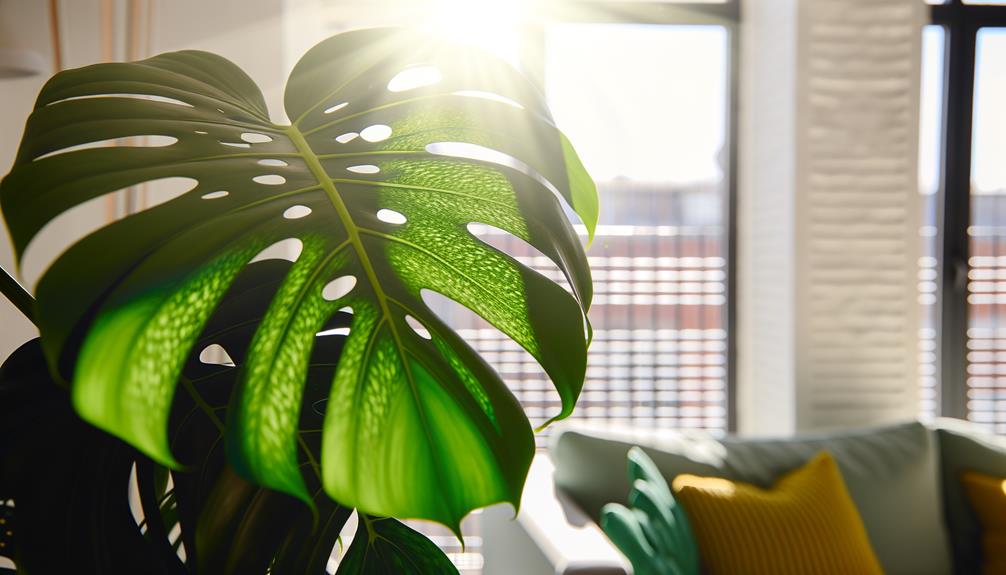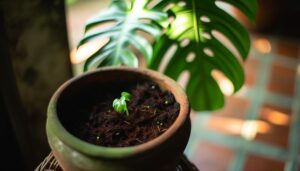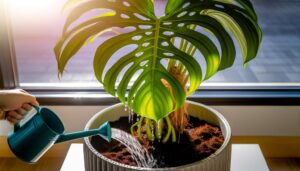Monstera Obliqua Care Yellow Leaves
Yellow leaves on your Monstera Obliqua usually signal problems with watering, light, or nutrition. Overwatering is the primary culprit, causing root rot and nutrient uptake issues.
Ensure well-draining soil to avoid waterlogged roots. Conversely, underwatering leads to dry, fragile leaves and retracted roots.
Proper light conditions are essential; too little light can result in photosynthesis disruption. Maintain high humidity (60-80%) to optimize gas exchange through stomata.
Nutrient deficiencies in iron, magnesium, or potassium can also manifest as yellow leaves. Pests like spider mites or aphids can exacerbate the problem by feeding on sap.
Learn more to keep your Monstera thriving.

Key Takeaways
- Yellow leaves often result from overwatering, which leads to root rot and nutrient uptake disruption.
- Ensure Monstera obliqua receives bright, indirect light to prevent yellowing due to inadequate light conditions.
- Maintain high humidity levels (60-80%) to support healthy foliage and prevent yellowing from dry air.
- Use well-draining, nutrient-rich soil to prevent root rot and ensure the plant receives essential nutrients.
- Regularly inspect for pests like spider mites, aphids, and mealybugs, which can cause yellow leaves.
Overwatering Issues
Overwatering is one of the primary causes of yellow leaves in Monstera obliqua, as it leads to root rot and disrupts the plant's ability to uptake essential nutrients. When the soil remains waterlogged, oxygen levels around the roots decrease, causing anaerobic conditions. These conditions promote the growth of pathogenic fungi, which attack the roots.
As the roots deteriorate, they can't effectively absorb water and nutrients, leading to chlorosis—a yellowing of the leaves due to nutrient deficiencies. In addition, compromised roots hinder the plant's ability to perform photosynthesis efficiently, exacerbating the yellowing.
To prevent overwatering, make sure the pot has adequate drainage and that the top inch of soil is dry before you water the plant again.
Underwatering Signs
A clear indication of underwatering in Monstera obliqua is the development of dry, fragile leaves that lose their vibrant green color. When a Monstera obliqua doesn't receive sufficient water, its cells can't maintain turgor pressure, leading to wilted, delicate foliage.
The lack of moisture disrupts the plant's ability to photosynthesize effectively, causing chlorophyll degradation and subsequent yellowing. Additionally, the roots may retract and shrink, impairing nutrient uptake. You might also notice leaf edges curling inward, a physiological response aimed at reducing water loss.
Make sure you water consistently, allowing the soil to dry slightly between waterings but not completely desiccate. Regular monitoring of soil moisture can help prevent these underwatering symptoms and keep your Monstera obliqua thriving.
Light Requirements
To prevent yellow leaves on your Monstera obliqua, you need to understand its light requirements. This plant thrives in bright, indirect light, as direct sunlight can cause photoinhibition and chlorophyll degradation.
If natural light is insufficient, supplement with artificial light sources that mimic the sun's spectrum.
Optimal Light Conditions
For Monstera obliqua, ensuring ideal light conditions involves providing bright, indirect sunlight to mimic their natural tropical habitat while avoiding direct exposure that can scorch the delicate leaves.
Position your plant near an east or north-facing window where it can receive filtered light. The chlorophyll in its leaves requires sufficient light for photosynthesis, but excessive light intensity can lead to photoinhibition, damaging the chloroplasts and causing yellow leaves.
Utilize sheer curtains to diffuse harsh rays, ensuring adequate light penetration without causing thermal stress. Monitor the leaf coloration and growth rate; pale or leggy growth indicates insufficient light, while yellowing and burnt edges suggest overexposure.
Adjust placement gradually to prevent shock and maintain top-notch physiological function.
Avoid Direct Sunlight
Positioning your Monstera obliqua to avoid direct sunlight is essential to prevent photodamage and maintain its intricate leaf structure. Direct sunlight can cause chlorophyll breakdown, leading to yellowing leaves and compromised photosynthesis. Aim for bright, indirect light to mimic the plant's natural understory habitat.
| Light Condition | Effect on Plant |
|---|---|
| Direct Sunlight | Leaf burn, yellowing |
| Bright Indirect | Optimal growth |
| Low Light | Slower growth, leggy |
| Filtered Light | Healthy foliage color |
Monitor light exposure by observing leaf response. If leaves are curling or browning, adjust the plant's position. Understanding the light requirements ensures the Monstera obliqua's cellular functions remain intact, promoting healthy growth and preventing yellow leaves.
Indoor Light Sources
You should utilize specific indoor light sources like LED grow lights to replicate the bright, indirect light conditions essential for Monstera obliqua's best photosynthesis and growth. These specialized lights emit a spectrum that closely mimics natural sunlight, providing the necessary wavelengths for chlorophyll production and energy conversion.
Position the grow lights about 12-18 inches above the plant to avoid leaf scorch while guaranteeing adequate light penetration. Maintain a consistent light cycle, ideally 12-14 hours daily, to mimic the plant's natural tropical environment.
Avoid placing the plant in low-light areas, as insufficient light can cause etiolation, where the plant becomes leggy and yellow leaves appear due to reduced chlorophyll synthesis. Proper lighting guarantees robust, healthy foliage.
Humidity Levels
Maintaining high humidity levels is essential for Monstera obliqua, as insufficient moisture can cause the plant's delicate leaves to yellow and deteriorate. Aim for humidity levels between 60-80% to mimic its native tropical environment.
The plant's stomata, tiny pores on the leaf surface, regulate gas exchange and water vapor release. Low humidity stresses these pores, leading to desiccation and yellowing.
To increase humidity, try:
- Using a humidifier: Provides consistent moisture.
- Grouping plants together: Creates a microenvironment with higher humidity.
- Placing a tray of water nearby: Enhances ambient moisture via evaporation.
- Misting the leaves: Offers temporary relief, though not a long-term solution.
Soil Quality
Maintaining prime soil quality is crucial for Monstera obliqua, as the plant flourishes in a well-draining, nutrient-rich medium that prevents root rot and promotes healthy growth. You should use a soil mix that contains organic matter, perlite, and orchid bark. This mix enhances aeration and moisture retention while preventing waterlogging. The plant's roots need oxygen to function effectively, and a well-aerated soil ensures this.
Here's a recommended soil mix:
| Component | Percentage | Function |
|---|---|---|
| Organic Matter | 40% | Nutrient provision |
| Perlite | 30% | Enhanced drainage |
| Orchid Bark | 30% | Root aeration |
Inadequate soil quality can lead to yellow leaves due to poor root health. Maintain prime soil conditions by repotting every two years.
Nutrient Deficiencies
You might notice yellow leaves on your Monstera Obliqua due to nutrient deficiencies affecting its chlorophyll synthesis and overall cellular function.
Identifying deficiency symptoms such as interveinal chlorosis or necrotic spots is essential for accurate diagnosis.
To correct nutrient imbalances, you'll need to adjust fertilization practices based on the specific nutrients lacking, ensuring proper uptake and absorption.
Common Nutrient Deficiencies
Insufficient levels of essential nutrients like nitrogen, magnesium, and iron can lead to the yellowing of Monstera obliqua leaves, as these elements are important for chlorophyll production and overall plant health.
Nitrogen is critical for amino acid synthesis and cellular growth.
Magnesium acts as the central atom in chlorophyll molecules, facilitating photosynthesis.
Iron is essential for electron transport within chloroplasts.
To address these deficiencies, consider the following:
- Nitrogen Deficiency: Use a balanced, water-soluble fertilizer.
- Magnesium Deficiency: Apply Epsom salts diluted in water.
- Iron Deficiency: Use chelated iron supplements.
- General Nutrient Support: Regularly check soil pH to guarantee nutrient absorption.
Identifying Deficiency Symptoms
Diagnosing nutrient deficiencies in Monstera obliqua involves observing specific symptoms like interveinal chlorosis, necrosis, and stunted growth.
Interveinal chlorosis, where leaf veins remain green while the areas between turn yellow, often indicates a lack of iron or magnesium.
Necrosis, or dead tissue, presents as brown, crispy edges or spots and typically signifies potassium deficiency.
Stunted growth may reflect nitrogen shortfall, essential for leaf and stem development.
Phosphorus deficiency manifests as dark, purplish foliage and poor root growth.
Calcium deficiency might cause new leaves to appear distorted or curled.
Inspect your Monstera closely, noting these signs, to accurately identify the underlying nutrient issues. This understanding is crucial for maintaining its vibrant health and lush appearance.
Correcting Nutrient Imbalance
To correct nutrient imbalances in your Monstera obliqua, start by adjusting the soil's pH to maximize nutrient availability, targeting a range between 5.5 and 7.0. Nutrient uptake is highly dependent on pH levels; an incorrect pH can lead to deficiencies or toxicities. Use a soil pH tester to gauge current levels and amend with sulfur or lime as needed.
Addressing nutrient deficiencies requires a balanced fertilizer. Look for a formula rich in:
- Nitrogen to promote healthy leaf growth.
- Phosphorus for root development.
- Potassium to enhance overall plant vigor.
- Micronutrients like magnesium, iron, and zinc for chlorophyll production and enzyme function.
Regularly monitor your Monstera obliqua's response to adjustments and make incremental changes to avoid overstressing the plant.
Pest Problems
Dealing with pest infestations is crucial when Monstera obliqua leaves start turning yellow, as common pests like spider mites, aphids, and mealybugs can disrupt the plant's physiological processes.
These pests feed on the plant's sap, depriving it of essential nutrients and water. Spider mites create web-like structures on the underside of leaves, reducing photosynthesis. Aphids excrete honeydew, leading to sooty mold growth that blocks sunlight. Mealybugs form waxy, cotton-like masses, weakening the plant's overall health.
To manage these pests, inspect your plant regularly, especially the underside of leaves. Use insecticidal soap or neem oil to treat infestations. Maintain proper air circulation and humidity levels to create an inhospitable environment for these pests.
Conclusion
Coincidentally, if you address overwatering, underwatering, light, humidity, soil, nutrients, and pests, your Monstera obliqua's yellow leaves might just turn green again.
Maintaining ideal water balance prevents root rot and dehydration. Proper light and humidity levels are essential for photosynthesis and transpiration.
Nutrient-rich soil fosters robust growth, while addressing deficiencies and pests secures the plant's health.
By synchronizing these care aspects, you'll provide an excellent environment for your Monstera obliqua, transforming it into a lively houseplant.






